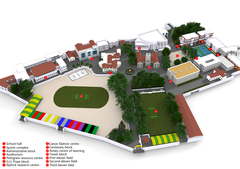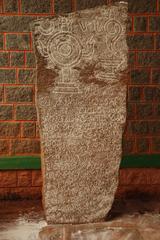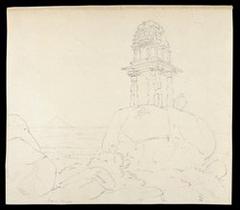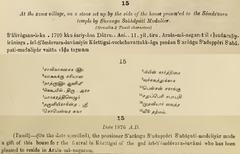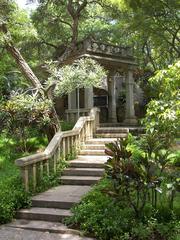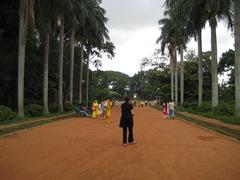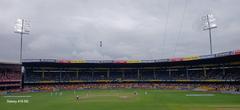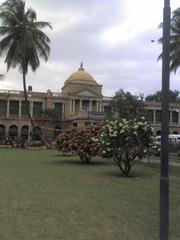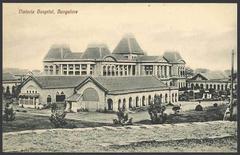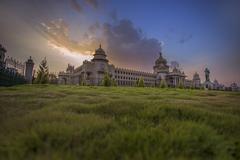Ranganathaswamy Temple Bangalore: Visiting Hours, Tickets, and Travel Guide
Date: 15/06/2025
Introduction
The Ranganathaswamy Temple in Bangalore, nestled in the vibrant Chikkapete area, is a revered spiritual and cultural landmark that stands as a testament to the city’s rich South Indian heritage and Vaishnavite traditions. Originally established in the 16th century during the Vijayanagara Empire, it is dedicated to Lord Ranganatha—a reclining form of Lord Vishnu symbolizing cosmic rest and sustenance. The temple’s architectural marvels and its role as a hub for religious and cultural festivities make it an essential destination for both devotees and those interested in history, architecture, and local traditions (Wikipedia, Temple in Karnataka, Trek Zone).
This guide provides detailed insights into the temple’s history, architectural features, visiting information, ticketing, accessibility, nearby attractions, and practical travel tips—ensuring you have a fulfilling and informed visit.
Historical Background
Origins and Development
The Ranganathaswamy Temple traces its origins to the 16th century CE, flourishing under the patronage of the Vijayanagara Empire. Its foundation is rooted in the Vaikhanasa tradition of Hinduism, with Lord Ranganatha as the principal deity, flanked by Bhudevi and Neeladevi. The temple has been a spiritual anchor in Bangalore’s Chikkapete area for centuries (Wikipedia).
Architectural Significance
This temple is a classic example of Vijayanagara style, characterized by robust granite pillars, intricately carved mandapas, and towering gopurams adorned with stucco sculptures. Influences from the Hoysala dynasty are visible in the detailed carvings and ornamentation. The temple complex includes subsidiary shrines, a kalyani (stepped well), and the sacred Garuda Sthamba (Temple in Karnataka).
Cultural and Religious Importance
The temple is a focal point for Vaishnavite worship, aligning with rituals from the Vaikhanasa and Pancharatra Agama traditions. It serves not only as a place of worship but also as a center for community gatherings and cultural events. Major festivals like Rathotsavam (Chariot Festival), Vaikunta Ekadashi, and Rama Navami are celebrated with great pomp, drawing thousands of devotees and fostering communal harmony.
Preservation and Community Role
Despite centuries of urban change, the temple has retained its significance through ongoing preservation efforts and active community participation. Rituals, festivals, and charitable activities ensure that the temple remains both a living spiritual institution and a custodian of Bangalore’s heritage.
Temple Architecture and Layout
- Gopuram (Gateway Tower): The multi-tiered gopuram marks the temple entrance, decorated with sculptures of deities and mythological scenes.
- Sanctum Sanctorum (Garbhagriha): Houses the main deity, Lord Ranganatha, depicted in a unique standing posture in Bangalore, accompanied by Bhudevi and Neela Devi.
- Mandapas: Pillared halls used for rituals and cultural events, featuring carvings from Vijayanagara and Hoysala periods.
- Subsidiary Shrines: Dedicated to deities like Rama, Sita, Hanuman, Venugopala Krishna, and Lakshmi.
- Kalyani: A ritual stepped well used for purification ceremonies.
- Decorative Elements: Panel friezes, ceiling medallions, and vibrant stucco work depict stories from the Ramayana, Mahabharata, and other Puranic texts.
Visiting Information
Visiting Hours
- Daily Timings: 6:00 AM to 12:00 PM, and 4:00 PM to 8:00 PM.
- Festival Days: Extended hours may be observed. Check in advance for special timings.
Entry and Tickets
- General Entry: Free for all visitors.
- Special Poojas/Sevas: May require a ticket or donation, available at the temple office.
- Guided Tours: Local guides can be arranged; audio and virtual guides may also be available.
Accessibility
- Wheelchair Access: The temple is generally accessible, though some areas may have steps. Ramps and assistance are available—contact the temple in advance for special needs.
- Elderly Visitors: Facilities are provided to ensure comfort.
Dress Code and Etiquette
- Attire: Modest clothing required; traditional Indian attire recommended.
- Footwear: Must be removed before entering the temple.
- Photography: Permitted in outer courtyards but restricted inside the sanctum sanctorum. Always seek permission before taking photos.
Festivals and Special Events
- Rathotsavam (Chariot Festival): Major annual event with processions and community participation.
- Vaikunta Ekadashi: Celebrated in December–January, with special rituals and decorations.
- Rama Navami & Janmashtami: Marked by devotional music, processions, and cultural programs.
- Brahmotsavam: Features elaborate ceremonies and community feasts.
Travel Tips and Nearby Attractions
- Getting There: Centrally located in Chikkapete, accessible by Bangalore Metro, city buses, auto-rickshaws, and taxis.
- Parking: Limited; public transport is recommended.
- Nearby Attractions:
- KR Market: Bustling local marketplace.
- Tipu Sultan’s Summer Palace: Historic Indo-Islamic structure, 2 km away.
- Bull Temple: Another iconic religious site in Bangalore.
- Chickpet Shopping Area: Known for textiles and jewelry.
Practical Information
- Facilities: Public restrooms, footwear storage, and basic refreshments are available nearby.
- Safety: The temple is safe; keep personal belongings secure, especially during crowded festivals.
- Best Time to Visit: Early mornings or weekdays for a peaceful experience; festivals for vibrant celebrations.
Frequently Asked Questions (FAQ)
Q1: What are the Ranganathaswamy Temple visiting hours?
A1: 6:00 AM to 12:00 PM and 4:00 PM to 8:00 PM daily; special hours during festivals.
Q2: Is there an entry fee?
A2: Entry is free; special poojas may require a ticket or donation.
Q3: Is the temple accessible for differently-abled visitors?
A3: Yes, but some areas have steps. Contact the temple office for assistance.
Q4: Is photography allowed?
A4: Permitted in courtyards; restricted in the sanctum and during rituals.
Q5: Are guided tours available?
A5: Yes, through local guides or by prior request at the temple office.
Visual Resources
Image Alt Text: Front view of Ranganathaswamy Temple Bangalore showcasing Vijayanagara architectural style
Ranganathaswamy Temple Magadi: Overview
Introduction
In Magadi, Karnataka, the Ranganathaswamy Temple (Dakshina Tirupati) is another outstanding example of South Indian Dravidian architecture and devotion. Located about 45 km from Bangalore, it is a significant pilgrimage site, especially during Vaikuntha Ekadashi. The temple is accessible by road, with regular buses and taxis from Bangalore (Gotirupati.com).
Visiting Hours and Entry
- Daily Hours: 8:30 AM to 7:30 PM; extended to 9:00 PM during major festivals.
- Entry: Free; special poojas and sevas require tickets available at the counter.
Facilities
- Cloakroom: Footwear storage available.
- Restrooms: Basic amenities near the entrance.
- Food: Local snacks and free prasadam during festivals.
- Accommodation: Limited in Magadi; Bangalore offers more options.
Accessibility
- Seniors and Differently-Abled: Traditional architecture may present challenges; assistance is typically available.
Dress Code
- Modest, traditional attire is encouraged. Footwear to be removed before entry.
Festivals
- Major Festivals: Vaikuntha Ekadashi, Dhanurmasam, and Vijayadashami with special rituals and extended hours.
Nearby Attractions
- Explore Magadi’s additional heritage sites, or use Bangalore as a base for broader travel.
Image alt text: Ranganathaswamy Temple Magadi showcasing Dravidian architecture
Image alt text: Map showing location and nearby attractions of Ranganathaswamy Temple in Magadi
Summary and Key Travel Tips
- The Ranganathaswamy Temple in Bangalore is a prominent heritage and religious site, notable for its Vijayanagara architecture, accessible visiting hours, and free entry.
- The temple is centrally located, making it easy to combine with other historical sites such as the Bull Temple and Tipu Sultan’s Summer Palace.
- Plan visits during early mornings for tranquility or during festivals for vibrant celebrations.
- Use public transport due to limited parking and bring cash for offerings or sevas.
- Respect local customs—modest dress, no footwear inside, and limited photography.
For additional information and updated timings, refer to official and trusted resources (Wikipedia, Temple in Karnataka, Trek Zone).
Sources and Further Reading
- Wikipedia: Ranganathaswamy Temple, Bengaluru
- Temple in Karnataka - Sri Ranganathaswamy Temple Bangalore
- Trek Zone - Ranganathaswamy Temple Bangalore
- Wikipedia: Ranganathaswamy Temple, Srirangam
Enhance your experience by downloading the Audiala app for guided audio tours and real-time updates on temple events. Follow us on social media for more travel inspiration and tips on exploring Bangalore’s rich heritage.

